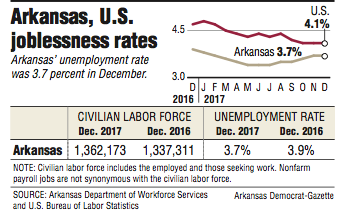Arkansas' unemployment rate was unchanged at 3.7 percent in December, the U.S. Bureau of Labor Statistics said Tuesday.
The national unemployment rate was 4.1 percent in December.
Arkansas' unemployment rate is "extremely low" and ranks as the 19th-lowest in the country, said Michael Pakko, chief economist at the Arkansas Economic Development Institute at the University of Arkansas at Little Rock.
Tuesday's report was the bureau's last before revisions of 2017 statistics are announced in March, Pakko said.
Pakko expects that the monthly unemployment rates will be revised. The bureau reported that the unemployment rate was 3.4 percent in May, June and July, the state's lowest unemployment rate in history.
"I wouldn't be surprised if once we see all the numbers that the unemployment rate didn't, in fact, fall below 3.5 percent," Pakko said.
Arkansas' labor force participation rate was 58.3 percent in December, said Mervin Jebaraj, director of the Center for Business and Economic Research at the University of Arkansas at Fayetteville.
The labor force participation rate is the percentage of the population from ages 16 to 64 that is working or seeking work. Most states have labor force participation rates above 60 percent, Jebaraj said.
"That is still a bit concerning," Jebaraj said.
The state's low labor force participation rate belies Arkansas' low unemployment rate, its job growth and its record-high employment, Jebaraj said.
There are several factors that contribute to the low labor force participation rate, Jebaraj said.
There are many long-term unemployed Arkansans who are discouraged and not in the labor force, Jebaraj said. To be nudged back into the labor force, they need retraining to get their skills up to date.
The state also lags the country in job growth, said Greg Kaza, executive director of the Arkansas Policy Foundation in Little Rock.
"Arkansas' job creation continues to trail the national average in the current economic expansion," Kaza said.
Since the recession ended in June 2009, the number of nonfarm payroll jobs in Arkansas has grown by 7.5 percent, Kaza said.
But that is well below the country's job growth of 12.5 percent, Kaza said.
Jebaraj noted that Arkansas' job growth was slow coming out of the recession.
"[The state's job growth] has had some faster growth rates in recent years," Jebaraj said. "But it's still not where we'd like it to be."
Seven industry sectors had job gains in 2017 and four others lost jobs.
Goods-producing jobs -- including the mining and logging sector, construction and manufacturing -- accounted for 8,200 jobs gained last year. Service-providing jobs -- which include all other jobs -- accounted for 7,900 jobs last year.
Manufacturing added 5,200 jobs in 2017, accounting for the bulk of those goods-producing jobs.
The educational and health services sector had the biggest increase in jobs, adding 5,800 jobs last year.
The trade, transportation and utilities sector had the biggest decline, losing 1,800 jobs last year, with retail trade accounting for all 1,800 jobs lost.
"We have lost quite a lot of jobs in retail trade," Jebaraj said. "It looks like we still haven't found a bottom in retail trade."
Unemployment rates in December fell in six states, rose in one state and were stable in 43 states, the Bureau of Labor Statistics said.
Hawaii's unemployment rate in December was 2 percent, the lowest in the country. Next were New Hampshire and North Dakota at 2.6 percent each, Nebraska at 2.7 percent, and Iowa and Vermont at 2.8 percent each.
Alaska had the highest unemployment rate at 7.3 percent, followed by New Mexico at 6 percent, West Virginia at 5.5 percent, and Nevada and New Jersey at 5 percent each.
Business on 01/24/2018
